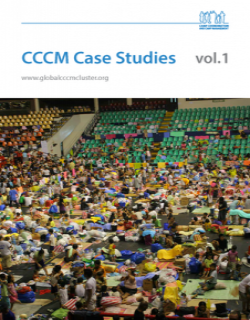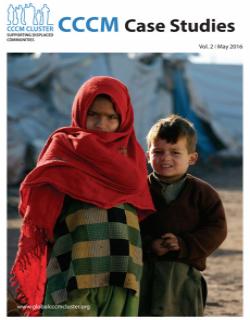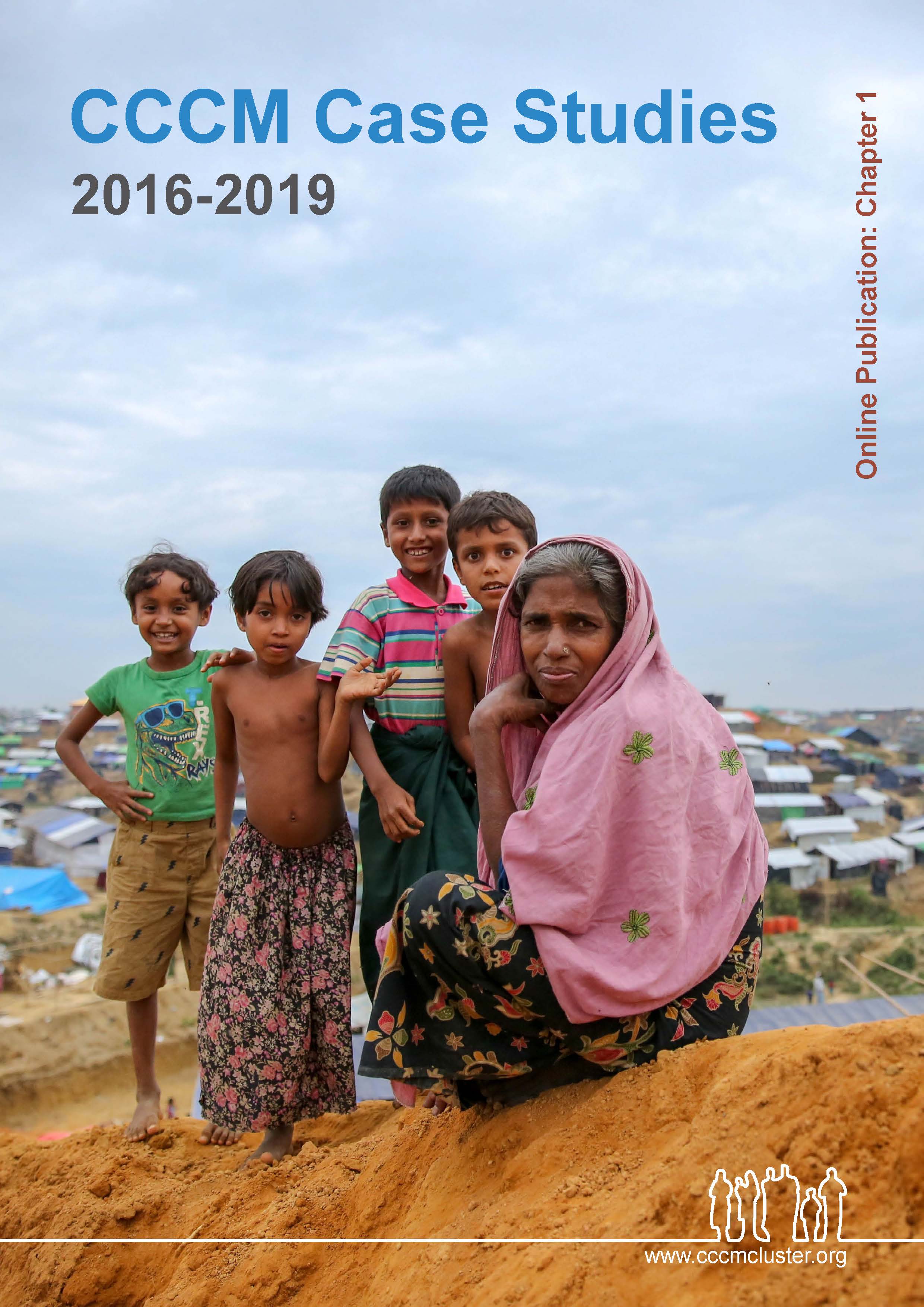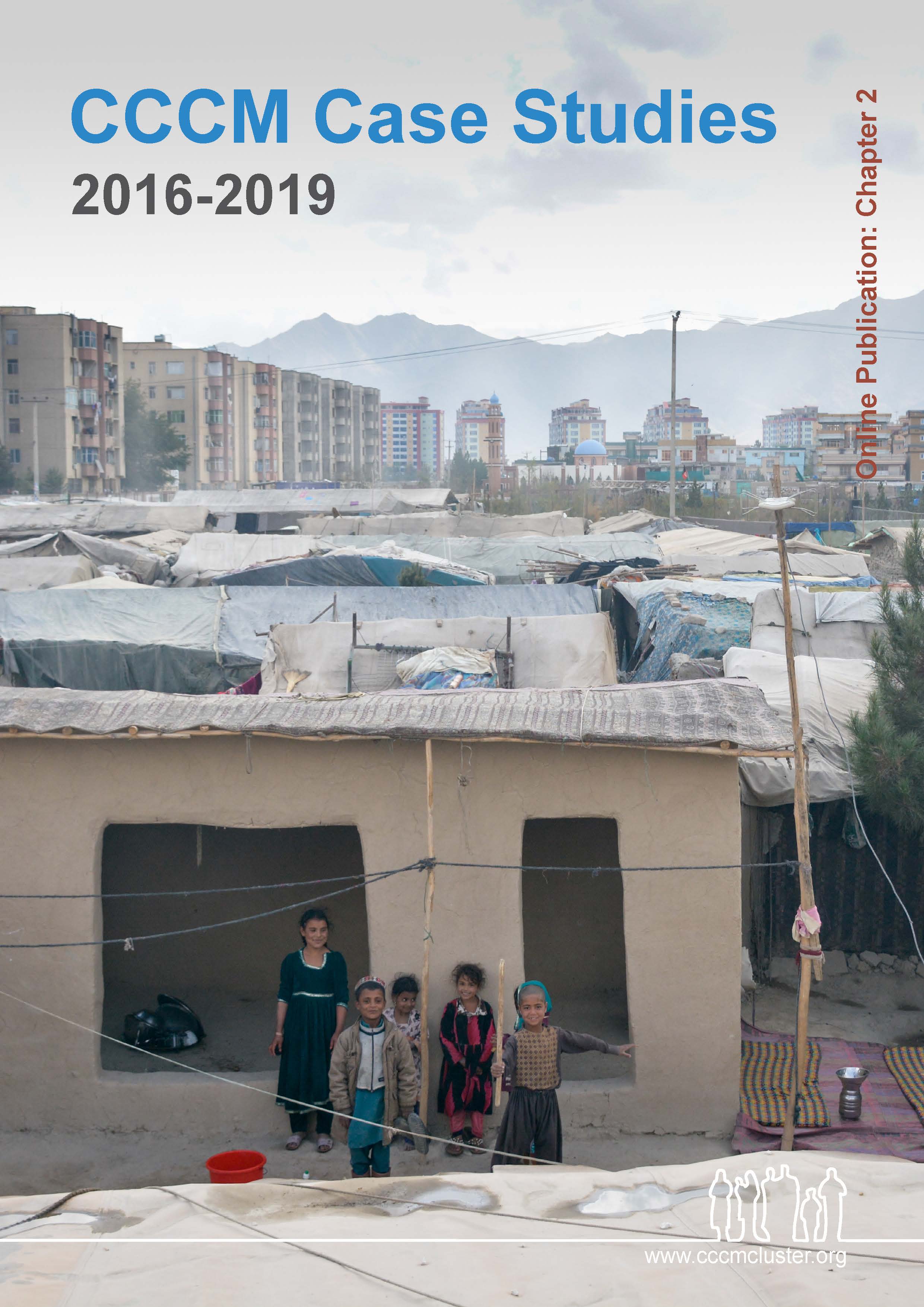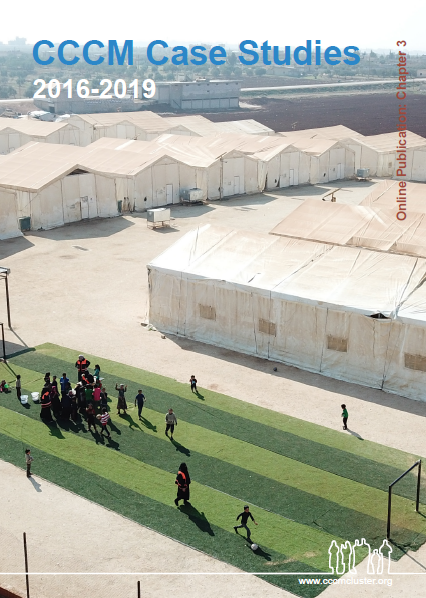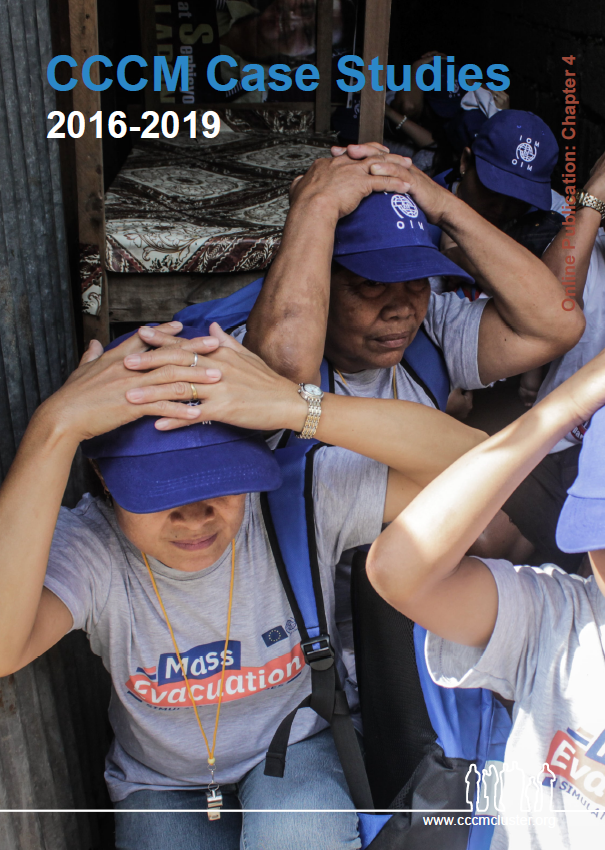Info! Please read the comments carefully.
Case studies from the Camp Management and Camp Coordination (CCCM) Cluster
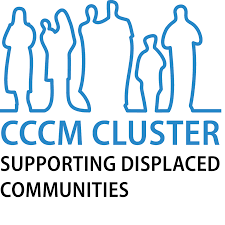
The boundaries on this map do not imply official endorsement nor acceptance.
The table below can be filtered by country, date range or article/emergency type. Use the "search" box to carry out a free-text search.
| Title | Year | Emergency | Article Type | Publication | Description | Keywords | Country | Year-start | Year-end | EmergencyTypeSimple | ArticleType | PublicationSimple | ChapterSimple |
|---|---|---|---|---|---|---|---|---|---|---|---|---|---|
| Title | Year | Emergency | Article Type | Publication | Description | Keywords | Country | Year-start | Year-end | EmergencyTypeSimple | ArticleType | PublicationSimple | ChapterSimple |
| A.1 Bangladesh | 2018-2020 | conflict | Case study | CCCM case studies 2020 | "In 2018, the Women’s Participation Project (WPP) was piloted in Leda camp, Cox’s Bazar, Bangladesh. As part of the project rollout, a baseline study was conducted to identify the numerous barriers to women’s engagement in camp management, level of participation in community decision-making processes and women’s role in the public sphere . Based on the findings and the pilot phase, membership to the Women’s Committee was expanded in 2019 to include women and adolescent girls with disabilities, promoting their engagement in daily activities in the camp, disaster preparedness and response as well as in livelihood programming." | Bangladesh | 0 | 2018-2020 | Conflict | case study | CCCM case studies 2020 | ||
| A.2 Bangladesh | 2018-2020 | conflict | Case study | CCCM case studies 2020 | "In 2020, the Women’s Participation Project (WPP) continued to evolve with the Women’s Committee members playing key roles in their community in relation to the current COVID-19 health response, along with their regular engagement in camp management activities." | Bangladesh | 0 | 2018-2020 | Conflict | case study | CCCM case studies 2020 | ||
| A.3 South Sudan | 2017-2020 | conflict | Case study | CCCM case studies 2020 | "The Community Disability Committee (CDC) is the primary governance and advocacy structure for IDPs with disabilities living in the Wau Protection of Civilians (PoC) site in South Sudan. Since arising as a community-based advocacy group for persons with disabilities in 2016-2017, CCCM has provided support to the committee in the form of consistent engagement, training for members, and facilitating regular elections to support changes in leadership. The CDC has become the most critical point for Camp Management and humanitarian partners to engage with IDPs with disabilities, serving as a forum for crucial information-sharing about the concerns and specific needs of persons with disabilities living in the site." | South Sudan | 0 | 2017-2021 | Conflict | case study | CCCM case studies 2020 | ||
| A.4 South Sudan | 2020-2021 | conflict | Case study | CCCM case studies 2020 | "The CCCM program worked with the Kondial FM radio talk show and conducted weekly live radio talk shows covering COVID-19 prevention guidelines and responding and debunking rumours that were actively discussed among community members. The program acted as a tool to empower and encourage civic engagement among a diverse set of individuals inside Bentiu PoC, and also included weekly feedback and listening groups so that community members could give direct input and opinions through phone and SMS." | South Sudan | 0 | 2020-2021 | Conflict | case study | CCCM case studies 2020 | ||
| A.5 Afghanistan | 2017-2021 | conflict | Case study | CCCM case studies 2020 | "Through this project, Camp Management supported the community in setting up a governance structure and established two-way communication and a referral pathway. The IDP committees communicated directly with the CM agency and service providers via coordination meetings that gave committee members the ability to discuss needs, gaps, and solutions. The governance structure prioritized women’s participation through dedicated women committees." | Afghanistan | 0 | 2017-2021 | Conflict | case study | CCCM case studies 2020 | ||
| B.1 Somalia | 2019-2020 | conflict | Case study | CCCM case studies 2020 | "Following the activation of the CCCM Sector in Somaliland, capacity building initiatives targeting local authorities, displaced communities and humanitarian partners were developed to introduce stakeholders to the newly activated sector. The initiatives aimed to improve stakeholders’ knowledge of the roles and responsibilities of actors involved in CCCM responses. The initiatives contributed to enhanced coordination and provided quality assistance and protection to the displaced communities living in urban sites." | Somalia | 0 | 2019-2020 | Conflict | case study | CCCM case studies 2020 | ||
| B.2 Yemen | 2019-2020 | conflict | Case study | CCCM case studies 2020 | "The Referral and Escalation System (RES) was developed to ensure the logging and tracking of site level multi-sector assistance gaps until" | Yemen | 0 | 2019-2020 | Conflict | case study | CCCM case studies 2020 | ||
| B.3 Indonesia | 2020 | conflict | Case study | CCCM case studies 2020 | "Localisation is a needed strategy in the Indonesia context as assessments and consultations found that there are gaps in understanding CCCM at a local level. Despite strong national disaster management, local actors often respond on an ad-hoc basis without a clear division of roles and responsibilities. As a first step, the CCCM Capacity Building Initiative used training as a platform to build local knowledge as well as to forge connections among Government, NGO and UN partners." | Indonesia | 0 | 2020 | Conflict | case study | CCCM case studies 2020 | ||
| B.3 Indonesia | 2018-2020 | conflict | Case study | CCCM case studies 2020 | "Lokalisasi adalah strategi yang diperlukan dalam konteks Indonesia karena berdasarkan penilaian dan konsultasi ditemukan bahwa ada kesenjangan dalam memahami CCCM di tingkat lokal. Terlepas dari manajemen bencana nasional yang kuat, para pelaku lokal seringkali merespons secara ad-hoc tanpa pembagian peran dan tanggung jawab yang jelas. Sebagai langkah pertama, Inisiatif Pengembangan Kapasitas CCCM menggunakan pelatihan sebagai platform untuk membangun pengetahuan lokal serta untuk menjalin hubungan antara Pemerintah, LSM dan mitra PBB." | Indonesia | 0 | 2018-2020 | Conflict | case study | CCCM case studies 2020 | ||
| B.4 Bangladesh | 2018-2021 | conflict | Case study | CCCM case studies 2020 | "“Light for Rohingya” is an innovative model that aimed to establish sustainable lighting provision to support safer access to hygiene and water installations for women and girls in the Cox’s Bazar refugee camps. Training was offered to Rohingya refugees and host community members to gain valuable technical skills to install, maintain and fix electrical lighting devices." | Bangladesh | 0 | 2018-2021 | Conflict | case study | CCCM case studies 2020 | ||
| B.5 Bangladesh | 2019-2020 | conflict | Case study | CCCM case studies 2020 | "The Capacity Sharing Initiative (CSI) is a comprehensive, multi-sectoral and inter-agency skills transfer and learning platform coordinated through the Site Management and Site Development (SMSD) Sector. The Initiative systematizes and channels humanitarian actors’ expertise to newly recruited government of Bangladesh site management staff. The CSI aims to ensure Rohingya refugees have access to adequate and equitable humanitarian assistance in line with technical standards, best practices and guiding principles by increasing the knowledge and operational skill set of government site management staff." | Bangladesh | 0 | 2019-2020 | Conflict | case study | CCCM case studies 2020 | ||
| South Sudan | 2019 | conflict | Case study | CCCM case studies 2020 | "Through an area-based, roving approach across four counties in Unity State, South Sudan, humanitarian partners support IDPs displaced by conflict, disease and food insecurity and returnees. Through this approach, CCCM partners target displaced persons who stay in temporary locations outside of formal camps or with the host community and lack both adequate information and coordinated service provision. The Beyond Bentiu Response (BBR) project addresses these challenges in hard-to-reach areas in the unique context of South Sudan." | South Sudan | 0 | 2019 | Conflict | case study | CCCM case studies 2020 | ||
| C.1 Chad | 2020 | conflict | Case study | CCCM case studies 2020 | "Following discussions with the Lake Chad Inter-Cluster Coordination Group (ICCG) about the security situation in Diamerom site, humanitarian actors and local authorities proposed voluntary relocation of IDPs to a safer location. Through the coordination of multiple stakeholders, including the displaced community, 12,634 IDPs relocated to Amma, an established site with access to livelihoods opportunities, and were supported with humanitarian assistance in their new location." | Chad | 0 | 2020 | Conflict | case study | CCCM case studies 2020 | ||
| C.2 Somalia | 2018-2019 | conflict | Case study | CCCM case studies 2020 | "This project underlines the salient CCCM theme of continued engagement with durable solutions partners and is an attempt to achieve durable solutions through specific coordination spearheaded by the CCCM Cluster. Through articulating a practical durable solutions concept that is supported by the government and institutional donors, there is optimism for further long-term housing solutions for vulnerable displaced individuals. As a result, this project exemplifies successes under the themes of transition and durable solutions." | Somalia | 0 | 2018-2019 | Conflict | case study | CCCM case studies 2020 | ||
| C.3 Nigeria | 2019-2020 | conflict | Case study | CCCM case studies 2020 | "Mafa had been underserved by the humanitarian community for some time, with relatively few partners operating there. This created the opportunity to implement a strategy for engagement that allows for a more holistic approach to address the needs of both the IDP and host communities. Three implementing agencies partnered up to pilot a cohesive Humanitarian-Development-Peace Nexus approach to respond to challenges in the relations between host and IDP communities." | Nigeria | 0 | 2019-2020 | Conflict | case study | CCCM case studies 2020 | ||
| C.4 Nigeria | 2020 | conflict | Case study | CCCM case studies 2020 | "The main objective of this project is to improve the protection of affected people of concern, restore human dignity and reduce suffering and disruption of Nigerian populations living in the 4 targeted local government areas (LGAs) through Camp Coordination and Camp Management (CCCM) services." | Nigeria | 0 | 2020 | Conflict | case study | CCCM case studies 2020 | ||
| C.5 Yemen | 2019-2020 | conflict | Case study | CCCM case studies 2020 | "The Site Management and Coordination (SMC) focal point for 54 sites (16,856 people) in the governorates of Aden and Al Dhale’e conducted regular assessments of the needs across sectors and coordinated assistance provision with relevant partners and clusters. The agency developed self-governance structures in the sites through the election of community committees and coordinated with national authorities to address new arising issues, such as eviction threats. To complement its CCCM activities, the lead agency directly implemented WASH and Shelter/NFI activities in the most vulnerable sites identified." | Yemen | 0 | 2019-2020 | Conflict | case study | CCCM case studies 2020 | ||
| D.1 Uganda | 2020 | conflict | Case study | CCCM case studies 2020 | "In response to increasing environmental degradation in refugee-hosting areas of Uganda, the ReForest Project was designed to protect existing forests and promote tree seedling planting. ReForest is a long-term, sustainable project that incorporates forest monitoring, maintenance and protection. Through this project, both refugee and host communities are able to benefit from improved access to energy resources and increased socio-economic inclusion." | Uganda | 0 | 2020 | Conflict | case study | CCCM case studies 2020 | ||
| Iraq, 2014 - present , Conflict | present | conflict | Case study | CCCM case studies Vol.3 Ch1 | The CCCM response to displacement in Iraq included support to more than 450,000 IDPs living in formal camp settings. In the Kurdistan region of Iraq, a CCCM mentorship consortium project provided training and mentorship to camp management teams in four districts. The project built capacity through a blend of formal training and on-the-job operational support that included coaching and advice on real-time camp management issues. | Iraq | 2014 | present | Conflict | case study | CCCM_Case Studies_Chapter 1_VOL 3 | ||
| Thailand , 2015, Conflict | 2015 | conflict | Case study | CCCM case studies Vol.3 Ch1 | The community-led governing bodies in the camps along the Thai/Myanmar border initiated a process to formulate housing and land-use guidance notes and trainings to address the unregulated and organic settlement patterns within the border camps3. The yearlong process led to the development of guidance notes to more effectively manage land use within the nine camps along the border by the community-led camp governing bodies. This included setting up community-led shelter working groups, community-led GIS mapping of the camps as well as conducting trainings on improved understanding and assistance to vulnerable households’ needs. | Thailand | 0 | 2015 | Conflict | case study | CCCM_Case Studies_Chapter 1_VOL 3 | ||
| South Sudan, 2016-2017, Conflict | 2017 | conflict | Case study | CCCM case studies Vol.3 Ch1 | The project took services closer to IDPs, host community members and returnees affected by the on- going conflict in Unity State through mobile outreach teams and static presence in line with the Beyond Bentiu Response Strategy. This facilitated restoring dignity among the affected population, provided opportunities for IDP returns and provided information to increase understanding in humanitarian operations. | South Sudan | 2016 | 2017 | Conflict | case study | CCCM_Case Studies_Chapter 1_VOL 3 | ||
| Afghanistan, 2018-Ongoing , Protacted Conflict | Ongoing | conflict | Case study | CCCM case studies Vol.3 Ch1 | The main project objective was to ensure that the displacement affected communities are protected and able to access life-saving assistance and durable solutions for their recovery. Activities included establishing and supporting community management structures (‘committees’) in informal settlements, Identifying needs and gaps - with focus on very vulnerable people who had fallen through the humanitarian assistance net - , sharing services and procedures information for accessing assistance, and establishing community centres for communities to access information, be referred to relevant services, access space for localised and inclusive coordination meetings, socialising/ recreational activities, and provision of services by third parties. | Afghanistan | 2018 | Ongoing | Protacted Conflict | case study | CCCM_Case Studies_Chapter 2_VOL 3 | ||
| Afghanistan, 2018-Ongoing , Drought | Ongoing | Drought | Case study | CCCM case studies Vol.3 Ch2 | The project was established in response to a wave of internal displacement and subsequent proliferation of informal sites accommodating the IDPs. The project was based on Camp Management methodologies, concentrating on the following outcomes/outputs: • Support to Coordination: through mapping informal sites and blocks/groups within them, undertaking IDP registration and intentions surveys, monitoring service provision (or lack thereof) and convening site-level coordination meetings. • Communication with Communities: through mobile teams, Community Tents, Community Meetings, theatre performances and identification of IDP focal points. • ‘Light’ Protection: through protection monitoring and referrals. | Afghanistan | 2018 | Ongoing | Drought | case study | CCCM_Case Studies_Chapter 2_VOL 3 | ||
| Iraq, 2017-Ongoing, Conflict | 2017- Ongoing | Conflict | Case study | CCCM case studies Vol.3 Ch2 | Centred around the strategy of Community Resource Centres(CRCs) as outreach hubs in the main governorates of return, Anbar, Diyala, Kirkuk, Ninewa and Salah al-Din. This coordination framework in partnership with the Joint Coordination and Monitoring Center (JCMC), on behalf of the Iraqi Government and in support of humanitarian and recovery/stabilization partners was charged with the establishment and operation of a network of CRCs to facilitate service delivery through information provision, referral to service providers and community engagement to support the safe, voluntary, non-discriminatory and sustainable returns and reintegration of mixed populations. | Iraq | 2017 | 2017- Ongoing | Conflict | case study | CCCM_Case Studies_Chapter 2_VOL 3 | ||
| Iraq, 2017-Ongoing, Conflict | Ongoing | Conflict | Case study | CCCM case studies Vol.3 Ch2 | The CCCM Cluster and partners adapted camp management to contexts across the Iraq response, including the use of mobile team responses for out-of-camp displacement settings. As nearly 70%3 of the refugee and IDP population settled outside of camps in often critical conditions, CCCM partners have sought to develop an out-of-camp response aimed at applying traditional CCCM core activities to the management of smaller pockets of IDP settlements predominately in urban and peri-urban areas. | Iraq | 2017 | Ongoing | Conflict | case study | CCCM_Case Studies_Chapter 2_VOL 3 | ||
| Lebanon, 2013-2018, Conflict (Syria) | 2018 | Conflict | Case study | CCCM case studies Vol.3 Ch2 | The Collective Site Management and Coordination (CSMC) programme started in 2013 as a Camp Management response to Syrian refugees in Lebanon. UNHCR established the term ‘Collective Site Management and Coordination’ in early 2014 to describe the informal nature of the camp response in Lebanon and to include collective shelter and collective centre management and coordination. The CSMC programme used a mobile approach centred around Community Capacity Building (CCB), in order to hand over site management and coordination responsibilities to refugees and local authorities, and thereby to reduce dependence on NGOs. The project was implemented in more than 250 Informal Settlements in the Bekaa Valley and North Lebanon, the implementing agency reaching nearly 40,000 refugees. The project involved the focus areas of establishing and training settlement committees; coordinating with service providers for service delivery at community level as well as referral of individual cases; and building the capacity of local authorities through staff secondment and training. | Lebanon | 2013 | 2018 | Conflict (Syria) | case study | CCCM_Case Studies_Chapter 2_VOL 3 | ||
| Somalia, 2017-Ongoing , Conflict/Drought | Ongoing | Conflict/Drought | Case study | CCCM case studies Vol.3 Ch2 | CCCM partners in Somalia have been using a mixed approach of traditional and mobile activities to respond to the 2.6 million displaced people in the country. Partners were focused on strengthening coordination of services, improving living conditions in sites through care and maintenance and ensuring diverse community governance systems for better overall site management. | Somalia | 2017 | Ongoing | Conflict/Drought | case study | CCCM_Case Studies_Chapter 2_VOL 3 | ||
| South Sudan, 2018-2019, Conflict in UN House PoC | 2019 | Conflict | Case study | CCCM case studies Vol.3 Ch2 | Following a sudden outflux of at least 3,000 IDPs from the Juba UN House Protection of Civilian (PoC) site after the outbreak of internal conflict, the CCCM cluster called on partners to launch one of the first formal mobile camp management responses in the country. The sudden displacement and the small population size meant that a full-scale camp management response was not required and the overall goal of the response was to support suddenly displaced people to equitably access humanitarian services and to ensure that the affected population is empowered to manage their own site management and coordination activities. | South Sudan | 2018 | 2019 | Conflict in UN House PoC | case study | CCCM_Case Studies_Chapter 2_VOL 3 | ||
| Bangladesh, 2018, Ethnic Violence | 2018 | Ethnic violence | Case study | CCCM case studies Vol.3 Ch.3 | The Site Management Project aims to improve the living standard of the camp population and host community in Cox’s Bazar by upporting the government of Bangladesh’s Office of the Refugee Relief and Repatriation Commission (RRRC) Camp in Charge to ensure equitable access to services and protection for displaced Rohingya living in Camp 15 (Jamtoli). The project established community development structures through a system of block and sub-block committees (BDCs) to ensure effective and targeted delivery and monitoring of the services, assist with the relocation of vulnerable households, ensure accountability through a complaint-response mechanism and liaise across different activity-based committees. The project activities were coordinated with the site management sector and implemented within the framework of the sector strategy to improve quality of life and dignity and to advocate for solutions. | Bangladesh | 0 | 2018 | Ethnic Violence | case study | CCCM_Case Studies_Chapter 3_VOL 3 | ||
| Greece, 2015-2017, Influx/Outflux for Internartional Protection | 2017 | Influx/Outflux | Case study | CCCM case studies Vol.3 Ch.3 | From 2015-2017, the implementing agency engaged in site management support across Greece. The goal was to uphold dignity and strengthen access to basic rights for persons on the move in Greece. This goal was pursued through a range of interventions across sectors, both in and outside of sites. The implementing agency’s approach to Site Management Support (SMS) included a holistic multi-sector service provision. In Greece there was a heavy focus on protection, legal aid, food security, shelter, non-food items, WASH and education, capacity building of local actors and volunteer groups. | Greece | 2015 | 2017 | Influx/Outflux for Internartional Protection | case study | CCCM_Case Studies_Chapter 3_VOL 3 | ||
| Colombia, 2015-Ongoing, Conflict (Venezuela) | Ongoing | Conflict | Case study | CCCM case studies Vol.3 Ch.3 | The reception center entitled “Center for Integrated Assistance”, first of its kind, aims at temporarily addressing the urgent humanitarian and protection needs of the most vulnerable people fleeing from Venezuela, as well as supporting the response of the local authorities. The most noteworthy innovative elements of the facility stand in its eligibility determination algorithm, length of stay and rotation determination system and its exit strategy mechanism combining humanitarian and government efforts. | Colombia | 2015 | Ongoing | Conflict (Venezuela) | case study | CCCM_Case Studies_Chapter 3_VOL 3 | ||
| Turkey, 2011-Ongoing, Conflict (Syria) | Ongoing | Conflict | Case study | CCCM case studies Vol.3 Ch.4 | This case study describes how remote coordination and CCCM remote operations were effectively applied in the case of Gaziantep, as one of the most advanced good practice case study. | Turkey | 2011 | Ongoing | Conflict (Syria) | case study | CCCM_Case Studies_Chapter 3_VOL 3 | ||
| Nepal, 2011-2020, Natural Disaster | Earthquake | 2020 | Case study | CCCM case studies Vol.3 Ch.4 | Nepal has been at risk of multiple hazards, notably earthquakes and floods and there has been a continuing need to build community resilience following the devastation of the 2015 Gorkha earthquakes. The preparedness projects in Nepal focused on preparing for a mass displacement event by identifying open spaces and multipurpose infrastructure for use as emergency shelter. In addition, capacity building with local government officials and with local communities ensured that first responders to an emergency are prepared to establish and manage temporary settlements for displaced persons. | Nepal | 2011 | 2020 | Natural Disaster | case study | CCCM_Case Studies_Chapter 4_VOL 3 | ||
| Philippines, 2017-2017-2018, Natural Disaster | 2017-2018 | Cyclone | Case study | CCCM case studies Vol.3 Ch.4 | The Mass Evacuations in Natural Disasters (MEND): Disaster Risk Reduction and Resilience Building in Metro Manila’s Most Vulnerable Cities project aimed to build the resilience of the vulnerable populations constantly threatened by natural disaster, particularly the threat of a major earthquake. The project targeted the most vulnerable urban poor communities, particularly the informal settlements and slum areas along rivers and water ways. The preparedness approach of the project focused on capacity building with both local authorities and community members through gathering information about the target communities, hands-on trainings to refine and adapt local contingency plans and a final simulation exercise to stress test the evacuation plans. | Philippines | 2017 | 2017-2018 | Natural Disaster | case study | CCCM_Case Studies_Chapter 4_VOL 3 | ||
| Vanuatu, 2016-2016-Ongoing , Natural Disaster | 2016-Ongoing | Natural disaster | Case study | CCCM case studies Vol.3 Ch.4 | The MEND mission in Vanuatu was requested by the Government of Vanuatu in order to strengthen the disaster management processes of the humanitarian actors in the country and to promote disaster risk reduction, preparedness and response activities. A draft National Evacuation Plan was developed, incorporating sub-plans for three highpriority areas as indicated by the Government. Given Vanuatu’s high vulnerability to disasters, the mission sought to provide concrete guidance on ways to improve preparedness and decrease vulnerability for the local population, including those most at risk during displacement and disaster. | Vanuatu | 2016 | 2016-Ongoing | Natural Disaster | case study | CCCM_Case Studies_Chapter 4_VOL 3 | ||
| Iraq, 2014, Conflict | 2014 | Conflict | Case study | CCCM case studies Vol.2 | CCCM agencies form a consortium to provide training and mentorship in camp management to twelve government appointed IDP camp managers. The capacity building project aimed at strengthening the skills and knowledge of camp managers and their staff throughout the Dohuk Governorate through the provision of both formal trainings and on-the-job mentorship. | Iraq | 0 | 2014 | Conflict | case study | CCCM_Case Studies_VOL 2 | ||
| Iraq, 2014, Conflict | 2014 | Conflict | Case study | CCCM case studies Vol.2 | The overall aim of the project was to inform the humanitarian response to IDPs living in camp settings at an operational and strategic level. The project sought to facilitate the identification of needs and response gaps to support the upcoming Humanitarian Response Plan (HRP), as well as to allow camp management agencies to more easily monitor service delivery and changing conditions over time. | Iraq | 0 | 2014 | Conflict | case study | CCCM_Case Studies_VOL 2 | ||
| South Sudan, 2014, Conflict and Flood | 2014 | Conflict and flood | Case study | CCCM case studies Vol.2 | The CCCM Cluster expanded and improved the Bentiu Protection of Civilians (PoC) site to increase protection of the displaced population, accommodate growing numbers of IDPs and prevent flooding. | South Sudan | 0 | 2014 | Conflict and Flood | case study | CCCM_Case Studies_VOL 2 | ||
| Philippines, 2013, Typhoon | 2013 | Typhoon | Case study | CCCM case studies Vol.2 | This case study highlights the CCCM Cluster’s collaboration with the Protection Cluster to mitigate the risks of and respond to Gender-Based Violence (GBV) during an emergency response with large-scale displacement. The CCCM Cluster’s Displacement Tracking Matrix (DTM) aided the identification of vulnerable groups, such as unaccompanied minors at risk of trafficking and GBV in the immediate post-emergency displacement phase. | Philippines | 0 | 2013 | Typhoon | case study | CCCM_Case Studies_VOL 2 | ||
| Zambia, 2015, Land Ownership | 2015 | Land ownership | Case study | CCCM case studies Vol.2 | This case study highlights the role of the CCCM Cluster in building the capacity of local authorities, Red Cross volunteers and NGOs to respond to a displacement situation and manage a camp efficiently and ensure the participation of the affected population. | Zambia | 0 | 2015 | Land Ownership | case study | CCCM_Case Studies_VOL 2 | ||
| Burundi, 2006-2011, Conflict (Congolese) | 2011 | Conflict | Case study | CCCM case studies Vol.1 | This case study from the refugee camps in Burundi (2006-2011) covers the period when there was a dedicated international NGO Camp Manager and the subsequent handover of camp management responsibilities to national authorities.A CCCM training was conducted in order to develop some clarity, and resulted in the formulation and signing of a written agreement clearly stipulating which agency was responsible for which activities. The case study focuses on four specific themes that provide lessons regarding: environmental challenges, increasing community participation, involving host communities and handing over camp management activities to national authorities. | Burundi | 2006 | 2011 | Conlfict (Congolese) | case study | CCCM_Case Studies_VOL 1 | ||
| Colombia, 2011-2013, Conflict | 2013 | Conflict | Case study | CCCM case studies Vol.1 | The CCCM Cluster’s efforts in Colombia involved strengthening the temporary shelter coordination and management capacity of national authorities.The CCCM Cluster in Colombia adopted a holistic strategy to achieve this, including: the development of information management tools; joint programs between the Government of Colombia and the United Nations System; the adaptation of CCCM tools to the Colombian context, including a focus on gender and cultural issues, and the needs of conflict and natural disaster affected populations; and the transfer of capacity building methodologies to national, municipal and local authorities. These CCCM methodologies have created a pool of over 100 managers, and 1,465 people have received CCCM training over the last three years. | Colombia | 2011 | 2013 | Conflict | case study | CCCM_Case Studies_VOL 1 | ||
| Haiti, 2010-2013, Earthquake | 2013 | Earthquake | Case study | CCCM case studies Vol.1 | Since 2011, the Government of Haiti, with support from the CCCM/Shelter Cluster and partner agencies, has engaged in Cash Grants Rental Subsidy (CGRS) programs, which provide affected households with a cash stipend to cover one year’s rent, plus additional grants for livelihood or other types of assistance. From the beginning of the CGRS program in 2011 until the end of 2013, an estimated 63,000 families will have been relocated from camps using this approach. Camp closure was thus based on the respect for the rights of the displaced by ensuring that the decision to leave was informed and voluntary. The process involves considerable efforts dedicated to developing strategies for communication with beneficiaries. | Haiti | 2010 | 2013 | Earthquake | case study | CCCM_Case Studies_VOL 1 | ||
| Kenya, 2007-2008, Conflct | 2008 | Conflict | Case study | CCCM case studies Vol.1 | The CCCM Cluster was activated as a standalone cluster in January 2008 along with 11 other clusters.The cluster approach was activated because the country was overwhelmed by the crisis, despite the presence of a strong governance structure. The majority of the 11 clusters were phased out in August 2008 with the exception of Protection and Early Recovery. The roles of the CCCM Cluster were to provide support to KRCS in terms of camp infrastructure, registration and service provision. However, at the onset of the crisis the roles and responsibilities of all CCCM actors were not well established. Thus, a Memorandum of Understanding (MoU) was drafted, agreed, and signed by the KRCS and the CCCM Cluster. The CCCM Cluster played an integral role, providing advice and technical support to the KRCS. | Kenya | 2007 | 2008 | Conflct | case study | CCCM_Case Studies_VOL 1 | ||
| Namibia, 2011, Flood | 2011 | Flood | Case study | CCCM case studies Vol.1 | In 2011, Namibia experienced one of its worst floods in its history. A joint rapid assessment was conducted by the Government of the Republic of Namibia to gather information on the gaps and needs in the response. Based on the Camp Coordination and Camp Management (CCCM) assessment, and, recognizing the existing disaster risk management system and structures in place in Namibia, a capacity building program for the national disaster management authorities was developed from a CCCM training package. Further, this success led to the development of a contextualized Disaster Risk Management (DRM) training package. Two training packages were developed comprising of more than 80 simple and practical tools, which used images and illustrations to disseminate key messages. This attracted participants’ attention and enabled them to identify the messages in a faster and easier way, and they brought color and fun to the training. | Namibia | 0 | 2011 | Flood | case study | CCCM_Case Studies_VOL 1 | ||
| Pakistan, 2013, Conflict | 2013 | Conflict | Case study | CCCM case studies Vol.1 | The CCCM Cluster was responsible for three camps in the KPP FATA region. Its responsibilities entailed: identifying, monitoring and reporting on standards; and coordinating multi-sectoral services. Due to issues of gender-based violence (GBV) and security, with the high risk of abandoned tents being used to host suicide bombers, the Provincial Disaster Management Authority (PDMA) and CCCM partners decided to carry out a joint tent-to-tent survey to verify the actual number of IDP families residing in the camp. | Pakistan | 0 | 2013 | Conflict | case study | CCCM_Case Studies_VOL 1 | ||
| Pakistan, 2012, Flood | 2012 | Flood | Case study | CCCM case studies Vol.1 | Country-wide flooding in 2010, floods in Sindh and Balochistan in 2011, and the flooding in Sindh, Balochistan and Southern Punjab in 2012 and 2013 have together affected at least 29 million people and damaged or completely destroyed almost 3 million houses across the country. In 2011 the CCCM Cluster was not formally activated following the floods despite significant population displacements, which resulted in a gap in the response. To compensate, the temporary Settlement and Support Unit (TSSU) was rolled out under the Shelter Cluster to undertake CCCM-related roles, including tracking displacement and return trends, and supporting the identification of displaced people’s needs. As recovery activities were on-going in areas affected by the 2011 floods, three provinces were hit again by flash floods due to heavy rains in September 2012, causing widespread damage. Again, the TSSU team mobilized to monitor displacement trends and needs of populations in temporary settlements. | Pakistan | 0 | 2012 | Flood | case study | CCCM_Case Studies_VOL 1 | ||
| Philippines, 2012, Typhoon | 2012 | Typhoon | Case study | CCCM case studies Vol.1 | Camp Coordination and Camp Management (CCCM) Cluster collaborated closely with the Department of Social Welfare and Development (DSWD), and to develop a systematic disaster response during recurring natural disasters in the Philippines. This case study highlights the use of the Displacement Tracking Matrix (DTM). This is one of the tools that the Government of the Philippines and the CCCM Cluster have used during disaster responses. It provides timely and accurate data of displaced people’s locations and needs to support informed decision-making. When typhoon Bopha (Pablo) hit the Visayas and Mindanao regions in December 2012, the CCCM Cluster immediately rolled out the DTM. At the same time, the DTM itself evolved by receiving feedback from field operations during the recurring natural disaster responses. | Philippines | 0 | 2012 | Typhoon | case study | CCCM_Case Studies_VOL 1 | ||
| Thailand, 2011-2012, Flood | 2012 | Flood | Case study | CCCM case studies Vol.1 | In 2011, Thailand was hit by the worst flooding it has experienced in over 50 years. The compounding effects of extreme weather events overwhelmed all water management systems, and one fifth of the country was inundated. The flood waters spread all the way from Ayutthaya to Bangkok. The CCCM Cluster assisted in the procurement of food and non-food items (NFIs). At a later stage in the disaster response, CCCM also provided capacity building trainings to strengthen the competencies of the Thai authorities in preparedness, mitigation, and collective center management. This case study focuses on the second stage of the response. The trainings were successful and prompted further requests for capacity building from the national authorities. CCCM also created short video clips to promote better collective center coordination and management among local and national authorities, and communities. | Thailand | 2011 | 2012 | Flood | case study | CCCM_Case Studies_VOL 1 | ||
| Uganda, 2005, Internal Civil Conflict | 2005 | Conflict | Case study | CCCM case studies Vol.1 | In 2005, the Cluster Approach was rolled out in Northern Uganda as a pilot project for Humanitarian Reform. The CCCM sector was initially rolled out as a branch of the Protection Cluster. CCCM was initiated just after the peak displacement and, after 6 months, shifted its focus to camp closure and phase-out activities. The CCCM Cluster was tasked to develop and pilot a camp phase-out and closure program, which was later used asthe flagship model for the rest of Northern Uganda and is the basis for this case study. | Uganda | 0 | 2005 | Internal Civil Conflict | case study | CCCM_Case Studies_VOL 1 | ||
| Yemen, 2009-2013, Conflict | 2013 | Conflict | Case study | CCCM case studies Vol.1 | The CCCM activities in this project included: •Strengthening the capacity building of local NGOs already working with IDPs outside camps. •Supporting local organizations to develop IDP community centers in key regions. •Utilizing outreach mobile programmes in Amran and Sa’ada to access remote areas far from the community centers. •Facilitating the dissemination of vital information among stakeholders (National authorities, humanitarian community, NGOs, development actors, beneficiaries, host community). •Encouraging the multi-functionality of the centers. IDPs frequently used the community centers as a meeting point to engage with other IDPs. •Providing financial and technical assistance to the IDP community centers. | Yemen | 2009 | 2013 | Confllct | case study | CCCM_Case Studies_VOL 1 |


